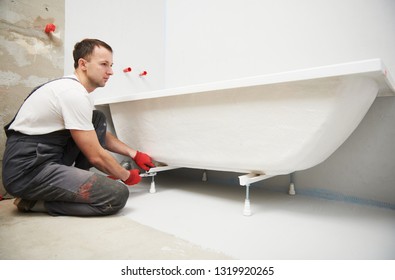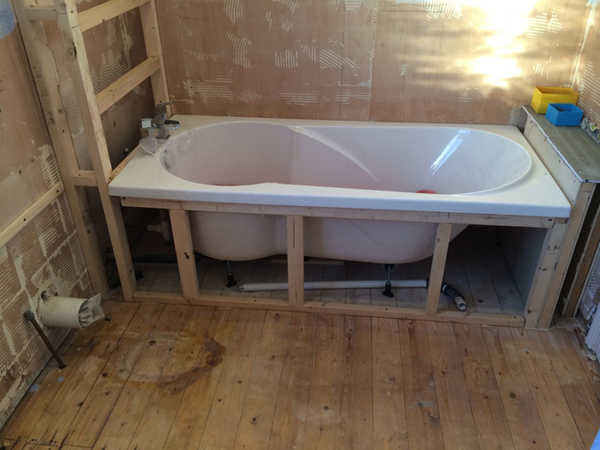How to Replace a Bathtub Yourself: Removing and also Replacing.
How to Replace a Bathtub Yourself: Removing and also Replacing.
Blog Article
We've stumbled upon the article on A Step-by-Step Guide to Installing a Bathtub down the page on the web and concluded it made good sense to share it with you here.

Installing a bathtub isn't specifically rocket science, yet it does need solid plumbing, carpentry, and occasionally, tiling skills. Replacing an old bath tub with a new one is also a reasonably challenging project. If the old bathtub is easily accessible, the task can move speedily; if you need to open a wall surface to eliminate the old tub as well as position the new bathtub, the job is much harder. In either instance, the project is within a house handyman's abilities, although you will certainly need an assistant to move out the old bathtub and embeded in the new one. See to it you have certified yourself for the job as well as are comfortable trying it. Rather than employing a professional to take control of a halfway-completed project, it is far better to take into consideration employing one prior to you begin. Opportunities are you may require an expert plumber to make tube connections.
This post will assist you mount a brand-new tub in your washroom if you have currently bought a brand-new bathtub and do not need to alter the setup of your previous supply of water pipes.
Your tools and also material list need to comprise the following:
Removing Old Taps
If you need to change old taps with new ones as a part of your installment, after that the first thing you ought to do is detach the water. After doing so, turn on the faucets to drain pipes any water staying in the system. The process of eliminating the existing faucets can be fairly problematic because of the limited accessibility that is frequently the situation.
Utilize a container wrench (crowsfoot spanner) or a faucet device to undo the nut that connects the supply pipes to the faucets. Have a towel ready for the remaining water that will originate from the pipelines. As soon as the supply pipelines have been removed, utilize the exact same device to loosen the nut that holds the faucets onto the bath/basin. You will certainly require to quit the single taps from turning during this process. When the taps have been removed, the holes in the bath/basin will have to be cleaned up of any type of old securing substance.
Prior to going on to fit the brand-new taps, compare the pipe connections on the old taps to the new taps. If the old taps are longer than the brand-new faucets, after that a shank adapter is needed for the brand-new faucets to fit.
Suitable New Touches
If the tails of the brand-new faucets are plastic, after that you will need a plastic port to avoid damage to the thread. One end of the port fits on the plastic tail of the tap as well as the other end offers a connection to the existent supply pipes.
If you need to fit a monobloc, then you will require reducing couplers, which attaches the 10mm pipe of the monobloc to the basic 15mm supply pipe.
Next, position the tap in the placing opening in the bath/basin making certain that the washing machines remain in place in between the faucet and also the sink. Protect the tap in place with the manufacturer provided backnut. As soon as the faucet is safely in place, the supply pipes can be connected to the tails of the faucets. The faucets can either be linked by using corrugated copper piping or with normal faucet adapters. The previous type should be connected to the tap ends initially, tightening only by hand. The supply pipelines can later be connected to the various other end. Tighten both ends with a spanner after both ends have been attached.
Mounting the Tub
Utilizing the two wood boards under its feet, put the bathtub in the required placement. The wood boards are valuable in evenly spreading out the weight of the tub over the area of the boards as opposed to concentrating all the weight onto four tiny factors.
The next objective is to make certain that the tub is leveled all round. This can be attained by inspecting the spirit level and also changing the feet on the bathtub till the level reviews level.
To mount taps, fit all-time low of the furthest versatile tap port to the ideal supply pipe by making a compression sign up with; then do the exact same for the other faucet.
Switch on the water system and also check all joints and also new pipework for leakages and tighten them if required. Fill up the bath tub and additionally check the overflow electrical outlet and also the regular outlet for leakages.
Lastly, deal with the bath paneling as defined in the producer's user's manual. Tiling and securing around the bathtub must wait until the tub has actually been utilized at the very least once as this will certainly settle it right into its last setting.
Planning for the Installment
Firstly, the sustaining structure supplied with the bathroom should be fitted (if needed) according to the manufacturer's directions. Next off, fit the taps or mixer to the tub. When suitable the tap block, it is very important to make sure that if the tap includes a plastic washing machine, it is fitted between the bath and also the faucets. On a plastic bathroom, it is also practical to fit a sustaining plate under the taps system to avoid pressure on the bath tub.
Fit the flexible tap adapters to the bottom of both taps utilizing 2 nuts and also olives (sometimes supplied with the tub). Fit the plug-hole electrical outlet by smearing mastic filler round the sink electrical outlet opening, and then pass the outlet through the hole in the bathroom. Make use of the nut provided by the manufacturer to fit the plug-hole. Analyze the plug-hole outlet for an inlet on the side for the overflow pipeline.
Next off, fit completion of the flexible overflow pipe to the overflow electrical outlet. Afterwards, screw the pipeline to the overflow face which need to be fitted inside the bath. Make certain you make use of every one of the supplied washers.
Link the catch to the bottom of the waste electrical outlet on the bath tub by winding the string of the waste electrical outlet with silicone mastic or PTFE tape, and screw on the catch to the electrical outlet. Attach the bottom of the overflow tube in a similar manner.The bath ought to now be ready to be suited its last placement.
Tiling Around the Bath tub
In the location where the bathroom fulfills the floor tile, it is necessary to seal the joins with a silicone rubber caulking. This is necessary as the installation can relocate sufficient to fracture an inflexible seal, causing the water to penetrate the wall between the bath and the tiling, leading to issues with wetness and also feasible leakages to the ceiling listed below.
You can select from a range of coloured sealants to blend in your fixtures as well as installations. They are marketed in tubes and also cartridges, and also can securing spaces as much as a width of 3mm (1/8 inch). If you have a larger gap to load, you can load it with spins of drenched newspaper or soft rope. Remember to always fill the bath tub with water prior to securing, to allow for the motion experienced when the tub is in use. The sealer can split relatively very early if you do not consider this movement before securing.
Conversely, ceramic coving or quadrant ceramic tiles can be utilized to edge the bathroom or shower tray. Plastic strips of coving, which are easy to use as well as cut to size, are additionally quickly offered on the market. It is advisable to fit the floor tiles utilizing water-resistant or waterproof glue as well as grout.
Bathtub Installation
How Important Is A Bathtub To Your Home?
High-quality baths, showers, and other bathroom updates are necessary when considering a smart investment in your home. It’s a room that you go to every day and one that is constantly being used by guests.The bathroom is one of the top trafficked rooms in a home and also one of the most valuable in terms of home resale.
Install Piping Before Tub
You will be using your existing drain and waste vent system, but pipes required include the hot and cold water supply lines and a pipe leading to a shower head. A mixing valve and shower head are also needed. Air chambers may be required.
Position the Tub
Lower the tub into place so that the continuous flange fits against the wall studs and rests on 1’x4' or 2’x4' supports. Anchor the tub to the enclosure with nails or screws inserted through the flanges into the studs.
NOTE: Remember, bathtubs and shower stalls may require support framing. A bathtub filled with water is extremely heavy, so check building codes and framing support before installing the tub.
Assemble Drain Connections
Assemble the bathtub drain connections by connecting the tub overflow with the tub drain above the trap, not beyond it. The trap will have a compression fitting that screws over the arm of the overflow assembly.
Place a Pipe For the Shower Head
First, locate a brass female threaded winged fitting and attach it to a framing support via a screw or a nail. Then run a pipe up the wall for the shower head. Sweat or solder the other side of the brass fitting to the top of the pipe.
Attaching Hot and Cold Water Lines
Attach your water lines for both hot and cold by sweating these directly into the hot and cold ports of the mixing valve. The mixing valve will be how water enters the tub’s system, not by the pipes themselves.
Install the Spout
Extend a piece of 1/2 inch pipe, or whichever length is specified in the manufacturer’s instructions, for the tub spout. Sweat on a male threaded fitting at the end of the pipe or use a brass nipple of the proper length and a 1/2 inch cap.
NOTE: At this point you should have your rough-in plumbing work inspected before proceeding further.
Check For Leaks
Restore the water pressure and check the drain connection and the supply pipes for any sign of leaking.
estore the Bathroom Wall
Replace the wall with moisture-resistant drywall as a base for your wall covering. Seal the joints between the wall and your new tub with silicone caulk as protection against water seepage.
https://www.berkeys.com/2016/12/02/bathtub-installation-dallas/

Do you enjoy reading about How to Install a Bathtub? Try leaving a remark down the page. We'd be delighted to listen to your ideas about this posting. We are looking forward to see you back again in the near future. Sharing is caring. One never knows, you may be doing someone a favor. I love reading our article about How to Install a Bathtub Yourself.
Explore Report this page